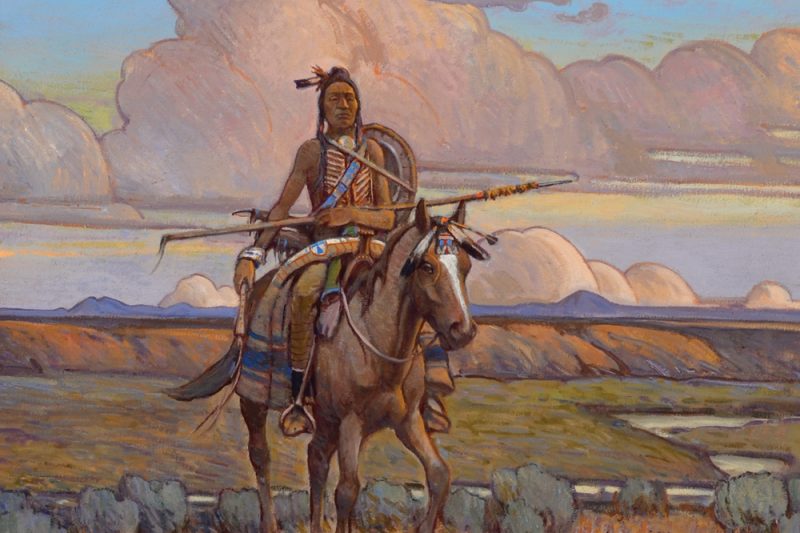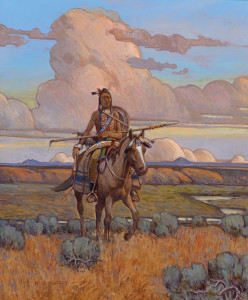
"In His Prime" by W. Steve Seltzer is part of The Russell
Steve Seltzer was just 23 when he participated in his first Russell Auction, which happened to be the very first Russell Auction. “It was a small-time affair,” he recalls. “I was lucky – I wasn’t that good of an artist yet, but it gave me, and others, an opportunity to grow.”

The Great Falls painter is entwined with the annual auction (March 17-19) and its beneficiary, the C.M. Russell Museum, in other ways too. His grandfather, western painter O.C. Seltzer, was a contemporary of Charlie Russell, and the museum has a sizable collection of the senior Seltzer’s work.
When the Russell Auction was in its infancy, back in 1969, Seltzer’s career was fledging too – as was enthusiasm for western art. “All of a sudden the art thing kind of caught on fire, and as the years went by, the art market got better and better,” he recalls. “Middle America had money to spend.”
The Russell Auction grew each year too, morphing into a nationally known affair. Its popularity, believes Seltzer, was boosted by a simple fact: “We had Charlie Russell. That was the key ingredient.”
“A lot of people don’t know how big his name is in the western art world,” he adds. “People come from all over the country as a kind of pilgrimage to his hometown.”
And his hometown has spread out the welcome mat. From that first event in 1969, up to a dozen art shows and sales have sprung up, attracting newcomers and old-timers to the Electric City each March for what’s now dubbed Western Art Week.
“It’s a big reunion,” says Seltzer. “There’s always a reason to come back. There’s always something new.”
The Russell-Seltzer connection
Olas Seltzer died in 1957 when his grandson was 13. Steve remembers visiting his grandparents at their house on Central Avenue, where his grandfather painted “in a little back bedroom.”
“He was very fastidious about his environment, very clean and neat – unlike my studio.”
On those rare occasions the grandkids witnessed him at work, “I remember thinking, ‘he’s not putting much paint on there.’”
More likely, they’d be invited to look at his collections of exotic bugs and butterflies, or his set of American commemorative stamps depicting famous artworks.
“As far as getting input, instruction or encouragement, no,” says Seltzer. “There was none.”
The elder Seltzer emigrated with his mother from Copenhagen, Denmark, and landed in Montana around 1890. Great Falls was a small town then, and Indians still set up large encampments along its western edge.
He met “Kid” Russell in 1897 at a local bar that was hosting a birthday party for the artist. Russell was 33 and Seltzer was 20. “My grandfather said ‘it was the most important day of my life.’”
The two men “hit it off real well,” adds Steve. “They had a mutual interest in painting and the history of the West.”
The young man was at a formative age. “Essentially, it shaped his career.”
“You develop your own thing”

When the younger Seltzer thinks about his grandfather, a plume of unanswered questions arises, from technical details, to curiosity about the time in which his grandfather and Russell lived, and the landscape and culture that were vanishing before their eyes. Those Native Americans who camped on the prairie near town: what were they like?
“I’m painting from secondhand sources,” says Seltzer. “I’ll never be able to compete with a Russell or a Seltzer, or any of the old timers who actually had a chance to see some of that.”
And of course the grandson wonders, “Would he like what I do?” Although Seltzer paints western themes, he’s also known for masterful landscapes and figurative works. The looser, more Impressionist style and broader subject palette were options his grandfather didn’t have.
“I don’t paint like him, but I tried to when I was young,” he recalls. “If any artist does it long enough, you develop your own thing. Like handwriting – it’s your own.”
As a professional artist, his grandfather made his living painting images of the West. “At the end, he was tired of it. He wore himself out,” says Seltzer. “His non-western things were wonderful, but they didn’t sell.”
“Maybe I can do this too”
Although his grandfather offered little in the way of direct encouragement, some spark landed in his grandson. “I thought, ‘hey, maybe I can do this too.’ I felt the same opportunity might be there for me.”
Seltzer began painting as a teenager, and made his first oil at 18. He majored in architecture at Montana State University, stopping just a quarter shy of a degree to take a job with an architectural firm in Great Falls. That didn’t fit, so he delved into real estate, but continued to paint.
Eventually, at 29, he began to paint full-time. He and his wife, Carol, moved to California in the mid ’70s where he shared a studio with his wife’s brother, well-known contemporary artist Dan McCaw.
“But I longed for Montana.” They moved back to Great Falls after four years “and I’ve been happy to be here ever since.”
Other than his design classes at MSU, Seltzer is largely self-taught. “I don’t recommend that. I could have shaved off about 20 years from my learning curve.”
He paints on location and from photographs, but never seeks to reproduce the camera’s image. “A good painting should tell you more about the artist than the subject matter. Otherwise it’s just a rendering exercise.”
He continues to thrive on diversity, and strives to challenge himself with new techniques and approaches. “I’ve made huge changes and continual growth in my work,” he says. “If you’re not progressing, you’re probably digressing.”
The Russell: “A great thing for Great Falls”
Carol Seltzer, a native of Butte, was born into a family of artists and married an artist. She taught high-school French for many years and has long volunteered at the C.M. Russell Museum as a docent.
More than 45 years as a volunteer have given her a broad understanding of the museum’s collections, connected her with people across the nation and around the globe, and enhanced her own appreciation of the art world. She especially enjoys working with children and participating in the annual fifth-grade art tours that precede the citywide essay contest, “Why I Like Charlie Russell.”
As a docent, she offers program on O.C. Seltzer, and her expertise led to an invitation from the Gilcrease Museum in Tulsa – which has an entire wing devoted to the senior Seltzer’s work – to train docents there.
“I’ve always loved the Russell Museum,” she says. “It’s such a treasure.”
“We both believe it’s a wonderful institution – a great thing for Great Falls,” adds her husband.
The museum is also home to at least 145 of his grandfather’s paintings – second only to its Russell collection. “I guess you could say we have a vested interest.”
– Kristi Niemeyer